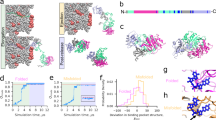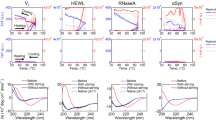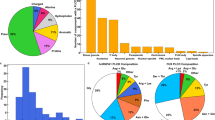Abstract
During expression of many recombinant proteins, off-pathway association of partially folded intermediates into inclusion bodies competes with productive folding. A common assumption is that such aggregation reactions are nonspecific processes. The multimeric intermediates along the aggregation pathway have been identified for both the P22 tailspike and P22 coat protein. We show that for a mixture of proteins refolding in vitro, folding intermediates do not coaggregate with each other but only with themselves. This indicates that aggregation occurs by specific interaction of certain conformations of folding intermediates rather than by nonspecific coaggregation, providing a rationale for recovering relatively pure protein from the inclusion body state.
This is a preview of subscription content, access via your institution
Access options
Subscribe to this journal
Receive 12 print issues and online access
$209.00 per year
only $17.42 per issue
Buy this article
- Purchase on SpringerLink
- Instant access to full article PDF
Prices may be subject to local taxes which are calculated during checkout
Similar content being viewed by others
References
Marston, F.A.O. 1986. The purification of eukaryotic polypeptides synthesized in Escherichia coli . Biochem. J. 240: 1–12.
DeBernardez-Clark, E. and Georgiou, G. 1991. Inclusion bodies and recovery of proteins from the aggregated state, pp. 1–20 in Protein Refolding. Georgiou, G. and DeBernardez-Clark, E. (eds.). American Chemical Society Symposium Series No. 470, Washington, D.C.
Thomas, P.J., Qu, B.-H., and Pedersen, P.L. 1995. Defective protein folding as a basis of human disease. TIBS 20: 456–459.
Wetzel, R. 1994. Mutations and off-pathway aggregation of proteins. Trends in Biotech. 12: 193–198.
Mitraki, A. and King, J. 1989. Protein folding intermediates and inclusion body formation. Bio/Technology 7: 690–697.
Zettlmeissl, G., Rudolph, R. and Jaenicke, R. 1979. Reconstitution of lactic dehydrogenase. Noncovalent aggregation vs. reactivation. 1. Physical properties and kinetics of aggregation. Biochem. 18: 5567–5571.
Cleland, J.L. 1993. Impact of protein folding on biotechnology, pp. 1–21 in Protein folding: In vivo and in vitro. Cleland, J.L. (ed.). American Chemical Society Symposium Series No. 526. Washington, DC.
Brems, D.N., Plaisted, S.M., Havel, H.A., and Tomich, C.S.C. 1988. Stabilization of an associated folding intermediate of bovine growth hormone by site-directed mutagenesis. PNAS USA 85: 3367–3371.
Lehrman, S.R., Tuls, J.L., Havel, H.A., Haskell, R.J., Putnam, S.D., and Tomich, C.S.C. 1991. Site-directed mutagenesis to probe protein folding: Evidence that the formation of a bovine growth hormone folding intermediate are dissociable processes. Biochem. 30: 5777–5784.
Mitraki, A., Betton, J.-M., Desmadril, M., and Yon, J.M. 1987. Quasi-irreversibility in the unfolding-refolding transition of phosphoglycerate kinase induced by guanidine hydrochloride. Eur. J. Biochem. 163: 29–34.
Mitraki, A., Fane, B., Haase-Pettingell, C., Sturtevant, J., and King, J. 1991. Global suppression of protein folding defects and inclusion body formation. Science 253: 54–58.
Mitraki, A., Danner, M., King, J. and Seckler, R. 1993. Temperature-sensitive mutations and second-site suppressor substitutions affect folding of the P22 tailspike protein in vitro. J. Biol. Chem. 268: 20071–20075.
Danner, M. and Seckler, R. 1993. Mechanism of phage P22 tailspike protein folding mutations. Protein Science 2: 1869–1881.
Wetzel, R. and Chrunyk, B.A. 1994. Inclusion body formation by interteukin-1 β depends on the thermal sensitivity of a folding intermediate. FEES Letters 350: 245–248.
Cleland, J.L., Hedgepeth, C., and Wang, D.I.C. 1992. Polyethylene glycol enhanced refolding of bovine carbonic anhydrase B: reaction stoichiometry and refolding model. J. Biol. Chem. 19: 13327–13334.
Tian, G., Vainberg, I.E., Tap, W.D., Lewis, S.A., and Cowan, N.J. 1995. Specificify in chaperonin-mediated protein folding. Nature 375: 250–253.
Goldberg, M.E., Rudolph, R., and Jaenicke, R. 1991. A kinetic study of the competition between renaturation and aggregation during the refolding of denatured-reduced egg white lysozyme. Biochem. 30: 2790–2797.
London, J., Skrzynia, C., and Goldberg, M. 1974. Renaturation of Eschericia coli tryptophanase after exposure to 8M urea. Eur. J. Biochem. 47: 409–415.
De Young, L.R., Dill, K.A., and Fink, A.L. 1993. Aggregation and denaturation of apomyoglobin in aqueous urea solutions. Biochem. 32: 3877–3886.
Jarrett, J.T. and Lansbury, P.T., Jr. 1992. Amyloid fibril formation requires a chemically discriminating nucleation event: studies of an amyloidogenic sequence from the bacterial protein osm B. Biochem. 31: 12345–12352.
Kocisko, D.A., Priola, S.A., Raymond, G.J., Chesbro, B., Lansbury, P.T., and Caughey, B. 1995. Species specificity in the cell-free conversion of prion protein to protease-resistant forms: A model for the scrapie species barrier. PNAS 92: 3923–3927.
Saraiva, M.J.M., Birken, S., Costa, P.P., and Goodman, D.S. 1984. Amyloid fibril protein in familial amyloidotic polyneuropathy, Portuguese type: definition of molecular abnormality in transthyretin (prealbumin). J. Clin. Invest. 74: 104–119.
Chargé, S.B.R., de Koning, E.J.P., and Clark, A. 1995. Effect of pH and insulin on fibrillogenesis of islet amyloid polypeptide in vitro. Biochem. 34: 14588–14593.
Speed, M.A., Wang, D.I.C., and King, J. 1995. Multimeric intermediates in the pathway to the aggregated inclusion body state for P22 tailspike polypeptide chains. Pro. Sci. 4: 900–908.
Teschke, C.M. and King, J. 1995. In vitro folding of phage P22 coat protein with amino acid substitutions that confer in vivo temperature sensitivity. Biochem. 34: 6815–6826.
Steinbacher, S., Seckler, R., Miller, S., Steipe, B., Huber, R., and Reinemer, P. 1994. Crystal structure of P22 tailspike protein: Interdigitated subunits in a thermostable trimer. Science 265: 383–386.
Haase-Pettingell, C. and King, J. 1988. Formation of aggregates from a thermolabile in vivo folding intermediate in P22 tailspike maturation. J. Biol. Chem. 263: 4977–4983.
Friguet, B., Djavadi-Ohaniance, L., Haase-Pettingell, C.A., King, J. and Goldberg, M.E. 1990. Properties of monoclonal antibodies selected for probing the conformation of wild type and mutant forms of the P22 tailspike endorhamnosidase. J. Biol. Chem. 265: 10347–10351.
Teschke, C.M. and King, J. 1993. Folding of the phage P22 coat protein in vitro. Biochem. 32: 10839–10847.
Gordon, C.L., Sather, S.K., Casjens, S. and King, J. 1994. Selective in vivo rescue by GroEL/ES of thermolabile folding intermediates to phage P22 structural proteins. J. Biol. Chem. 269: 27941–27951.
Goldenberg, D. and King, J. 1982. Trimeric intermediate in the in vivo folding and subunit assembly of the tail spike endorhamnosidase of bacteriophage P22. PNAS 79: 3403–3407.
Goldenberg, D., Smith, D.H., and King, J. 1983. Genetic analysis of the folding pathway for the tail spike protein of phage P22. Proc. Natl. Acad. Sci. USA 80: 7060–7064.
Brems, D.N., Plaisted, S.M., Kauffman, E.W. and Havel, H.A. 1986. Characterization of an associated equilibrium folding intermediate of bovine growth hormone. Biochem. 25: 6539–6543.
Chen, C.-C., King, J., and Wang, D.I.C. 1995. Molecular thermodynamic model for helix-helix docking and protein aggregation. AIChE J. 41: 1015–1024.
Jaenicke, R. and Rudolph, R. 1986. Refolding and association of oligomeric proteins. Methods Enzymol. 131: 218–250.
Brunschier, R., Danner, M., and Seckler, R. 1993. Interactions of phage P22 tail-spike protein with GroE molecular chaperones during refolding in vitro. J. Biol. Chem. 268: 2767–2772.
King, J., Haase-Pettingell, C., Robinson, A.S., Speed, M., and Mitraki, A. 1996. Thermostable folding intermediates: inclusion body precursors and chaperonin substrates. FASEB J. 10: 57–66.
King, J. and Yu, M.-H. 1986. Mutational analysis of protein folding pathways. Methods Enzymol. 131: 250–266.
Shea, R.G. 1971. Genetic identification of phage P22 antigens and their structural location. PhD diss., Department of Biology, Massachusetts Institute of Technology, Cambridge, MA.
King, J., Griffin-Shea, R., and Fuller, M.T. 1980. Scaffolding proteins and the genetic control of virus shell assembly. Quart. Rev. Biol. 55: 369–393.
Sather, S. and King, J. 1994. Intracellular trapping of a cytoplasmic folding intermediate of the phage P22 tailspike using iodoacetamide. J. Biol. Chem. 269: 25268–25276.
Author information
Authors and Affiliations
Rights and permissions
About this article
Cite this article
Speed, M., Wang, D. & King, J. Specific aggregation of partially folded polypeptide chains: The molecular basis of inclusion body composition. Nat Biotechnol 14, 1283–1287 (1996). https://doi.org/10.1038/nbt1096-1283
Received:
Accepted:
Issue Date:
DOI: https://doi.org/10.1038/nbt1096-1283



